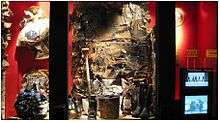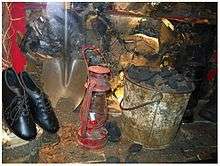Mink Building
The Mink Building is a five-story German-American style red brick structure at 1361-1369 Amsterdam Avenue between 126th and 128th Streets, in the West Harlem/Manhattanville neighborhood of New York City, originally part of a large brewery complex, inclusive of 1361 Amsterdam Avenue, 461 West 126 Street, 423 West 127 Street, 439-449 West 128 Street, 454 West 128 Street, and 460 West 128 Street.[1] In the late 19th century, beer brewing was an industry as big as finance or real estate in the 21st century New York City, yet few buildings survive to tell the story. The site of the complex at 1361 Amsterdam Avenue in Manhattan - predating residential development in Harlem - was chosen due to its relative isolation at the time.
The Mink Building site has variously housed the following breweries: Casper Heindel, Manhattan Brewery (10th Avenue & 128th Street);[2] 1865-1870 William Maack, Manhattan Brewery 1870-1875; Yuengling & Co., Manhattan Brewery 1875-1880; D. G. Vuengling, Jr., Manhattan Brewery 1880-1884; D. G. Yuengling Brewing Co. 1884-1897; John F. Betz, Manhattan Brewery (Amsterdam Avenue & 128th Street) 1897-1901; Betz & Sons Brewing Co. of New York City; Manhattan Brewery 1901-1903; and the Bernheimer & Schwartz, Pilsener Brewing Co.; readdressed to 127th to 129th & Amsterdam in 1903-1920, after which brewery operations were shut down by National Prohibition.
The property originally part of the Excelsior Brewery, followed by the Manhattan Brewery. While the Betz Brewery was operating, so was the Lion Brewery, owned by Max E. Bernheimer and his brother Simon, along with partners August Schmid and Anton Schwartz (April 23, 1853-November 6, 1910).[3] Both the Betz Brewery and the Lion were extremely successful. In 1875, David G. Yuengling, Jr. purchased the property in the dense, industrial enclave in the deep valley between Morningside and Hamilton Heights near the Hudson River. Nearby was the D. F. Tiemann pigment factory, a worsted mill. and the first buildings of Manhattan College. The following year, in 1876, The New York Times reported Yuengling Brewery establishment, whose structures make up a small town. . . now has equipment which comprises all the latest ideas in brewing science. It drew its pure water from artesian wells on the property which the newspaper said were “of unlimited capacity.” The giant red-brick brewery included a swimming pool and opulent parlors for entertaining dignitaries, who included King Edward VII of England. On August 7, 1903, the New York Tribune reported the sale of the property to J. F. Betz Brewery, which is considered one of the best brewery plants in equipment and one of the largest in size in this country. The complex included a single span bridge over and across West 128th Street.[4]
It would be two-years before the site for the Bernheimer & Schwartz Pilsener brewery complex was completed.[5] The malt house complex featured on a lithographic calendar in 1914 shows the complex in its heyday.[6] The Bernheimer & Schwartz Pilsener Brewing Company was extremely successful. The members of the Bernheimer family directly involved in the brewery company, Simon Emanuel Bernheimer (1849-1911), and Max E. Bernheimer (1855-1913); both Bernheimer brothers died suddenly.[7]
During prohibition, the complex was adapted for use by several businesses, including dairy, cold storage, and laundry. Most of the complex returned to brewery use for the Horton’s Pilsner Brewing Company in the 1930s, and according to a 1991 hearing statement New York Landmark Preservation Commission, 423-427 West 127th Street having been constructed in 1934-1926. Horton went out of business in 1941.
The building now described under 1361 Amsterdam Avenue, known as the Mink Building, eventually became in the 1940's. the site of Interborough Fur Storage Company, a storage facility where the wealthy stored their furs for the summer before becoming office space in the late 1990s. Current building owner Janus Property Company and Cushman and Wakefield lease approximately 137,000 square feet (12,700 m2) of space to commercial, nonprofit, and civic tenants.[8] The owners are currently building a complicated sub-grade structure required to occupy a sizable addition also underway at the old Malt House building.
History
An exhibition entitled "at Beer Here: Brewing New York’s Beer History" at The New York Historical Society in 2012 credits German immigrants, beginning in the 1830s, for bringing to New York a brewery tradition which ultimately triumphed, and by 1880, Yorkville, the Lower East Side, Williamsburg and Bushwick, all had become home to large populations of German immigrants, and also home to more than a hundred breweries.[9][10]
In July of 1923, The New York Times reported, A flood of prewar beer was let loose into Harlem sewers yesterday when Federal prohibition officers began the destruction of 836,000 gallons of non-de-alcoholized lager and 4,000 barrels of twelve-year-old ale at the plant of the Bernheimer Schwartz Pilsener Brewing Company, 128th Street and Amsterdam Avenue.[11] In 1933, an NY-U-230 permit for the operation of a brewery was granted to the Horton Pilsener Brewing Company, Inc. 1933-1941. [12][13]
Of the two brewery complexes that remain on the island of Manhattan, 1361 Amsterdam Avenue is part of a malt house complex considered the finest — with ethnic German architectural motifs — and the most complete.[14] Representative of Manhattanville’s otherwise vanished industrial past, the property was calendared for consideration as a historic landmark decades ago. In 2011, Manhattan Community Board 9 tried to put an end to the standoff between preservationists and developers last week, by voting overwhelmingly to remove the building from consideration as a historic landmark.[15]
Architect
Louis Oberlein, an architect working at the turn of the 20th century designed 1361 Amsterdam Avenue, possibly along with partner, Anthony Pfuend. A reminder of the period when brewing was a major industry in New York, this complex of buildings with frontages on Amsterdam Avenue, West 126th Street (formerly Lawrence Street), West 127th Street, and West 128th Street, is the larger, more architecturally distinguished and intact of the two groups of brewery buildings surviving in Manhattan. The buildings, designed mostly in the American Round Arch style popular for industrial buildings at the time, retain a strong sense of place and serve as reminders of a great industry.
Oberlein was originally employed by a firm called Lederle, Wessely & Company, which designed a building at 196 Broadway that has since been demolished. Oberlein started his own practice sometime after he was commissioned to design the Bernheimer & Schwartz Pilsener Brewing Company, the complex which included the structure currently known as The Mink Building. The architect designed not only the brewery but also surrounding buildings that met the company's other needs. Records indicate that Oberlein worked primarily for Bernheimer & Schwartz, although he designed the Mt. Kisco Brewing Company and a stock house, which still stands today at 37th Street and 1st Avenue in Manhattan.[16]
A review of the Mink building, as well as the stock house in mid-town, shows that Oberlein was skilled in the German-American style of building, perhaps contributing to his popularity with brewers. Bernheimer & Schwartz wanted their building to advertise their business, and so Oberlein was able to use German building characteristics to achieve this. This largely consisted of the decorative brick patterns found on the façade of the Mink Building. There is also usually an emphasis on floors, windows, and verticality in German-American architecture, all traits that Oberlein used to distinguish his buildings as German. According to the 1910 U.S. census, Louis Oberlein lived in Jersey City, New Jersey and worked in Manhattan, with his office on Whitehall Street.
Site and context
The Mink Building is located in northern Manhattan, adjacent to the Hudson River, in an area of Harlem known as Manhattanville.[17] This settlement in New York City holds a rich history of trade in the eighteenth and nineteenth centuries and even earlier in American history. Henry Hudson wrote a journal entry in 1609 in which he described an instance of trade with American Indians near what later became Manhattanville. Less than one century later, the Dutch had established the small village of Harlem on the opposite side of the island, and they used the area that Hudson had explored as fields for their animals to graze.[18] Even after New York became a British colony and then a state, this area maintained its status as a crossroads.
The village of Manhattanville was founded in 1806 and quickly gained prominence as an outpost of the city. The name Manhattanville is thought to have come from the original name for 125th Street - Manhattan Street.[19] According to Eric K. Washington, “With Manhattanville’s formation, the new village quickly became a significant suburban destination along the Bloomingdale Road [today’s 125th St.]... Manhattanville flourished naturally as a nexus of various transportation arteries.”[20]
In the late nineteenth century, Manhattanville experienced a development boom of residential buildings, churches, hospitals, institutional construction, and transportation made it a desirable location for the brewery business.
Form and use
The form of the Mink Building derives largely from its original use as a brewery owned by German-Americans. Although little is known about the architect Louis Oberlein, the owners of Bernheimer & Schwartz Co. likely hired him because of their shared heritage. Here was an architect who understood how to make a building stand out as German-American, a desirable trait for a German beer-maker. The Bernheimer & Schwartz Pilsener Brewing Company was arguably Oberlein’s biggest client, although he designed other buildings and even another brewery, the Mt. Kisco Brewery.
Materials and methods of construction
The Mink Building contains concrete slab floors supported by interior columns and load bearing masonry exterior walls. The floor slabs are visible on the façade as stylistic elements. Concrete is used to supplement the brick elsewhere on the façade, and reveals places of structural significance, such as the upper corners of the windows.
Public Art


The West Harlem Art Fund produced two window installations at the Mink Building located on Amsterdam Avenue. The first work was a group installation and the second installation was created by Harlem-based artist Dianne Smith called Gumboot Juba that was featured in 2011 during Armory Arts Week.
References
- ↑ http://www.nyc.gov/html/lpc/downloads/pdf/Backlog_95/Backlog_Fact%20Sheets/FactSheet_86-91.pdf
- ↑ One Hundred Years of Brewing: A Complete History of the Progress Made in the Art, Science and Industry of Brewing in the World, Particularly During the Last Century. H.S. Rich & Company. 1901.
- ↑ "Historic Beer Birthday: Anton Schwartz - Brookston Beer Bulletin". Brookston Beer Bulletin. 2018-04-23. Retrieved 2018-05-29.
- ↑ (N.Y.), New York (1918). The City Record: Official Journal.
- ↑ American Brewer's Review. 1903.
- ↑ Lithographic Calendar
- ↑ Brewers Journal. Gibson Publishing Company. 1913.
- ↑ "Meet Scott Metzner, the Developer Who's Transforming West Harlem". Commercial Observer. 2017-04-19. Retrieved 2018-05-29.
- ↑ Rothstein, Edward (2012-05-24). "'Beer Here,' on Brewing, at New-York Historical Society". The New York Times. ISSN 0362-4331. Retrieved 2018-05-29.
- ↑ "New-York Historical Society | Beer Here: Brewing New York's History". www.nyhistory.org. Retrieved 2018-05-29.
- ↑ "$1,000,000 IN BEER FLUSHES CITY SEWER; Passing of Berheimer & Schwartz Brewery Marked by Flow of 836,000 Gallons". The New York Times. 1923-07-13. ISSN 0362-4331. Retrieved 2018-05-29.
- ↑ "Tavern Trove :". www.taverntrove.com. Retrieved 2018-05-29.
- ↑ "BERNHEIMER & SCHWARTZ PILSENER BREW. CO. 127TH TO 129TH ST. & AMSTERDAM AVE O NEW YORK STRENGTH AND PURITY BERNHEIM AND SCHWARTZ Trademark of Heartland Brewery, Inc. - Registration Number 4765886 - Serial Number 86332525 :: Justia Trademarks". trademarks.justia.com. Retrieved 2018-05-29.
- ↑ https://www.huffingtonpost.com/todd-fine/the-mink-building-and-dis_b_8518826.html
- ↑ "Local Board Seeks to Boot Harlem's Mink Building From Landmark List". DNAinfo New York. Retrieved 2018-05-29.
- ↑ Real Estate Record and Builders' Guide. Publication. 1555 ed. Vol. 61
- ↑ Washington, Eric K. (2002). Manhattanville: Old Heart of West Harlem. Arcadia Publishing. ISBN 9780738509860.
- ↑ Eric K. Washington, Manhattanville: Old Heart of West Harlem, 7.
- ↑ "Manhattanville's History and Development in Harlem". Untapped Cities. 2013-02-26. Retrieved 2018-05-29.
- ↑ Washington, Manhattanville 9.